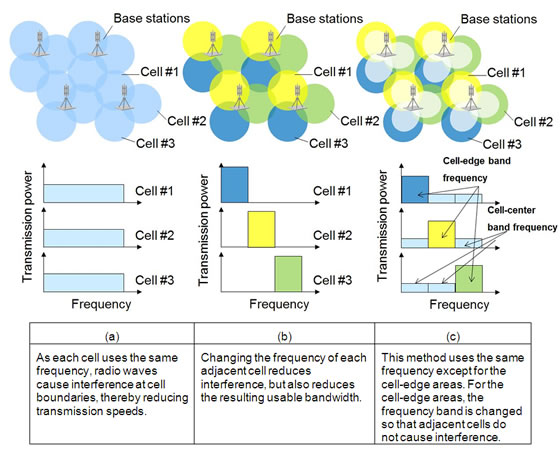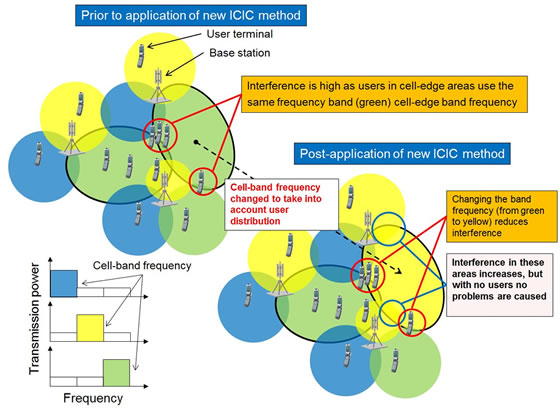Archived content
NOTE: this is an archived page and the content is likely to be out of date.
Fujitsu Develops Inter-Cell Interference Coordination Technology for LTE Base Stations Enabling Uninterrupted High-Quality Video Delivery
Autonomously controls signal interference at cell-edge areas making possible smooth mobile phone service from anywhere
Fujitsu Laboratories Ltd.
Kawasaki, Japan, May 18, 2011
Fujitsu Laboratories Ltd. today announced the development of a proprietary inter-cell interference coordination (ICIC) technology that eliminates signal interference at cell-edge areas covered by base stations of the cutting-edge long-term evolution (LTE) mobile phone system. The new technology is able to autonomously allocate frequency bands in order to reduce radio-wave interference in accordance with user distribution around cell-edge areas of overlapping cells of each adjacent base station. By deploying this technology to base stations, it is possible to double throughput at cell-edge areas, which would otherwise experience reduced transmission speeds due to signal interference.
This improvement in throughput will make it possible for users to enjoy services—such as high-quality video content delivery—from any location without interruption.
Details of this technology were presented at the 2011 IEEE 73rd Vehicular Technology Conference (VTC2011 Spring), held in Budapest, Hungary from May 15, 2011.
Background
In recent years, there has been enormous growth in mobile telecommunications traffic in line with the rapid spread of smartphones. LTE, the latest wireless communications standard that enables high-speed data communications of up to 150Mbps, is anticipated to support the ever-increasing demand for mobile broadband services. Even with LTE, however, in overlapping areas (cells) covered by adjacent base stations, inter-cell interference can lead to a significant degradation in user throughput and possible interruptions to video delivery and other mobile services.
In the future, amid increasing volumes of mobile communications traffic, technologies for reducing signal interference at cell-edge areas will be crucial in allowing users to enjoy seamless mobile broadband services from any location.
Technical Issues
As seen in Figure 1(a), signal interference becomes an issue at cell-edge areas when other overlapping base stations utilize the same frequencies. Figure 1(b) shows that by employing the frequency reuse (FR) technique, in which each of the adjacent cells utilize different frequencies, it is possible to reduce inter-cell interference. As a result, however, the frequency bandwidth available to each cell narrows and actually leads to lower throughput.
One way to overcome this issue is the fractional frequency reuse (FFR) method (Figure 1(c)), in which only overlapping parts of the cells undergo frequency reuse. This method allocates frequencies between areas close to a base station (cell-center areas) and areas far away from a base station (cell-edge areas). For cell-center areas, transmission power is lowered and the same frequencies are used in all of the cells. On the other hand, cell-edge bands have higher transmission power and undergo frequency reuse.
However, the ICIC method in Figure 1(c) assumes that all areas are equal. In actuality, however, inter-cell interference can still occur for the following reasons:
- Signal propagation characteristics of areas differ due to topography and buildings
- Different areas with base stations that have varying transmission power and antenna heights
- Distance between base stations is uneven due to space constraints
 Figure 1: Explanation of Conventional ICIC Methods
Figure 1: Explanation of Conventional ICIC Methods
Larger View (141 KB)
Newly Developed Technology
To address these issues, Fujitsu Laboratories developed an ICIC method for LTE that controls inter-cell interference by taking into account the impact of cell configuration and user distribution.
As conventional ICIC methods did not adjust for imbalances in the configuration of cells and the distribution of users, but instead allocated frequency bands of cell-edge area according to a geographical distribution of cells, adjacent cells could actually be using the same frequency (left, Figure 2). This newly developed technology, however, allows adjacent base stations to recognize each other's circumstances and change the frequency bands of cell-edge area in order to reduce inter-cell interference on users in the cell-edge areas.
 Figure 2: Overview of How the Newly-Developed Interference Coordination Method Works
Figure 2: Overview of How the Newly-Developed Interference Coordination Method Works
Larger View (118 KB)
Results
In an evaluation of simulation results achieved using the newly developed ICIC technology for LTE, when the configuration of cells was not uniform and the distribution of users was imbalanced, transmission speeds in the cell-edge areas roughly doubled compared to methods that did not control interference. As a result, even if many users congregate in the cell-edge areas, they can enjoy services, such as transmission of high-quality video content, without interruption.
Future Plans
Fujitsu Laboratories will plan how best to incorporate the newly developed ICIC into LTE base stations with the goal of commercializing the technology in 2-3 years.
About Fujitsu Laboratories
Founded in 1968 as a wholly owned subsidiary of Fujitsu Limited, Fujitsu Laboratories Limited is one of the premier research centers in the world. With a global network of laboratories in Japan, China, the United States and Europe, the organization conducts a wide range of basic and applied research in the areas of Next-generation Services, Computer Servers, Networks, Electronic Devices and Advanced Materials. For more information, please see: http://jp.fujitsu.com/labs/en.
Press Contacts
Public and Investor Relations Division
Inquiries
Company:Fujitsu Limited
Technical Contacts
Wireless Signal Processing Lab, Network Systems Laboratories
 Phone: +81 (46) 839-5370
Phone: +81 (46) 839-5370
 E-mail: press_icic@ml.labs.fujitsu.com
E-mail: press_icic@ml.labs.fujitsu.com
Company:Fujitsu Laboratories Ltd.
All other company or product names mentioned herein are trademarks or registered trademarks of their respective owners. Information provided in this press release is accurate at time of publication and is subject to change without advance notice.
This press release has been revised as of December 17, 2018.
Date: 18 May, 2011
City: Kawasaki, Japan
Company:
Fujitsu Laboratories Ltd.,
,
,
,
,
,
,
,
,
,
![]() Phone: +81 (46) 839-5370
Phone: +81 (46) 839-5370![]() E-mail: press_icic@ml.labs.fujitsu.com
E-mail: press_icic@ml.labs.fujitsu.com
